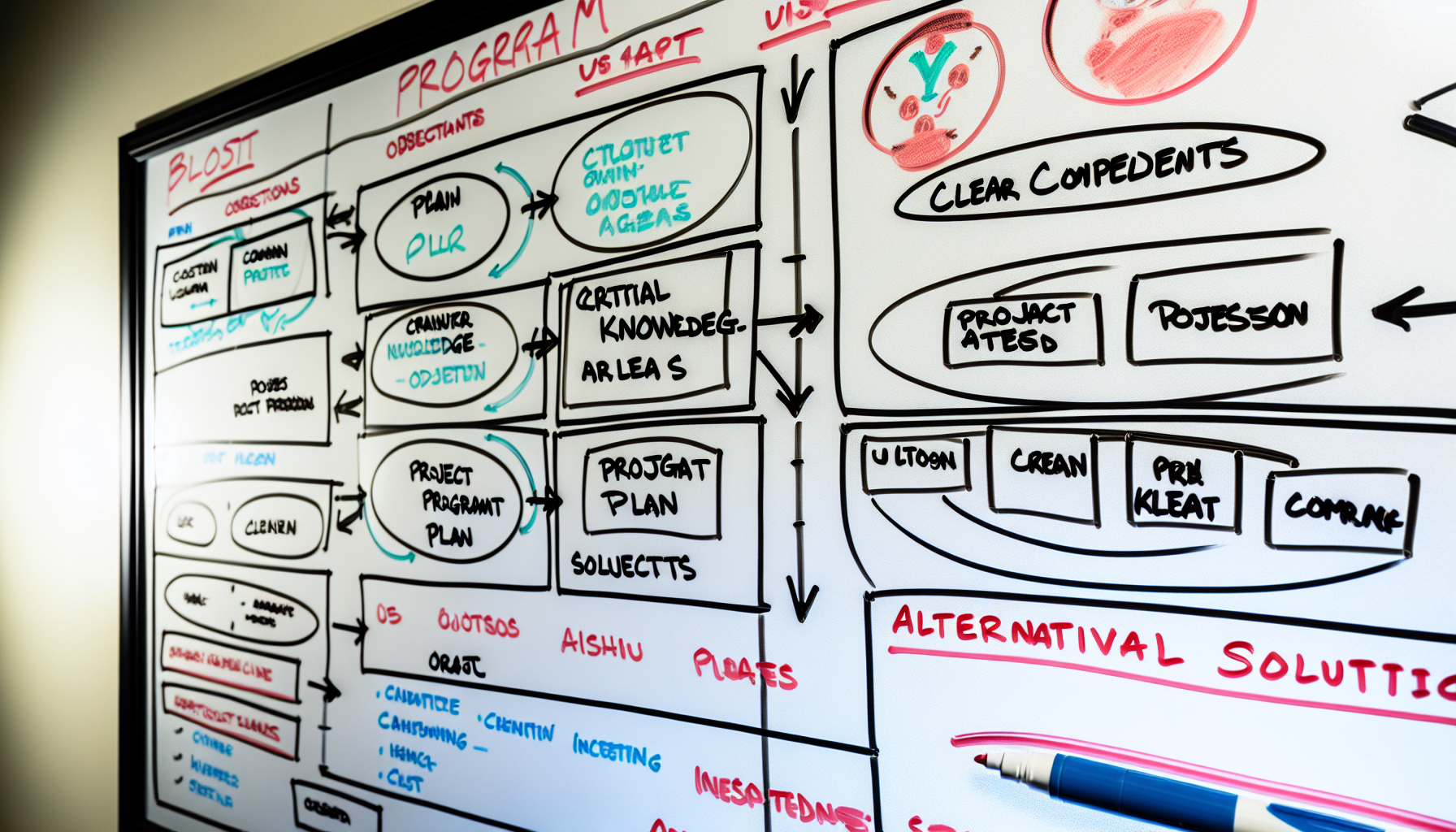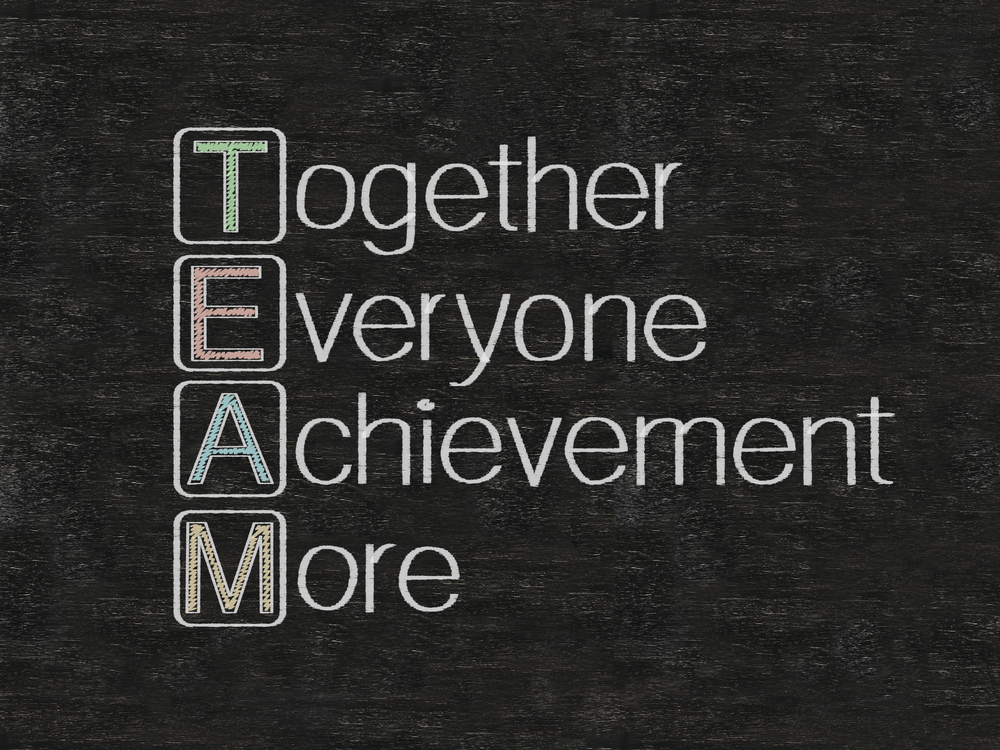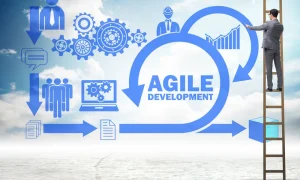Transforming strategic plans into successful outcomes is the essence of program management. This clear-cut article outlines the 10 best practices for program management success, directing you toward effective leadership of complex projects. It walks through establishing a robust PgMO, fostering effective communication, and harnessing software solutions, all with a focus on results.
Key Takeaways
- Establishing a strong Program Management Office (PgMO) is essential for ensuring effective governance, resource allocation, and alignment with organizational goals, as it harmonizes various projects and orchestrates their optimal execution.
- Developing a comprehensive program plan is the foundation for guiding a program to success, incorporating key components such as scope, cost, time, and risk, and necessitating regular updates to adapt to changing circumstances.
- Measuring and monitoring program performance through relevant Key Performance Indicators (KPIs) is vital for staying on track with project control variables, enabling proactive optimizations, and guiding strategic decision-making.
Establish a Strong Program Management Office
The successful conduct of program management requires a strong Program Management Office (PgMO). This acts as an anchor ensuring the proper governance, resource distributions and keeping in line with the company desires. One can consider PgMO as a conductor, coordinating various projects and making sure they fall under the grand plan of the organizations, while also minimizing the waste of resources. Knowing the project strategic context is vital inserting the project within long-side objectives and from a broader business perspective, as well, including potential ROI and budget but also resource constraints.
Further Reading: The Ultimate Decoding: Project Vs Program Manager Difference
Roles and Responsibilities
In summary, the PgMO has a considerable number of responsibilities and plays many roles . Foremost, it ensures a governance framework within the powerful duties and obligations and decision-making capabilities of every stakeholder in a venture is put in place. A messenger, which collects knowledge from multiple relevant sources and passes it on to its consumer.
PgMO strategically manages the resource allocation process and maintains effective project management while achieving strategic goals of an organization. Performs monitoring through performance assessment, which provides feedback for producing correct decisions to make a project successful.
Benefits of a PgMO
Having gained the proper structure, PgMO may provide the following important advantages. The first and probably the most important one is that the PgMO company acts as a lighthouse, which plays a key role in making sure every project strives to meet and deliver what’s important in our organization.
Secondly, the PgMO is the ever-vigilant sentinel, helping keep costs under control because they meticulously watch project spending and keep me informed. Finally, PgMO is a glass house. It’s more visibility and a clear line of communication for me, as well as everyone else. Finally, in the distant future, PgMO is a mentor/coach.
Develop a Comprehensive Program Plan
In conclusion, having a complete project plan plays an instrumental role in adequately manage your program. Additionally, it is vital to note that keeping the critical project documents up to date through the lifecycle of the project. It helps ensure that the plan as a whole stands as a source document, giving you a clear path to ensure your success.
Moreover, to effectively monitor and control the entire program, it would be advantageous to have a separate master project containing all the agency’s critical milestone links. This is in order so as to support the interconnection between the projects .
Finally, when defining strategic objectives for your program, it is crucial to consider how much or what proportion of the same the individual projects bring about. The values included are based on the direction in which resources are allocated with respect to the overall strategy.
Key Components
A good program plan consists of a number of vital components. First of all, it is the clear definition of what steps need to be taken to achieve the goal. Additionally, it is critical to include the items related to time, quality, scope, cost, physical and human resources, procurement, communication, risk management, and stakeholder management. Finally, one should assume all possible resolutions to the issue and choose the best one using financial, temporal, and opportunities constraints that establish a new bar.
Monitoring and Updating
It is essential for program managers to be constantly monitoring and revising the project plan. This is analogous to the way a ship’s captain modifies their course in response to altering winds and currents. One of the most important roles that consistent communication through frequent project meetings plays is in:
- Gathering updates
- Addressing any obstacles
- Ensuring steady progress of the project
- Adaptation to changes.
Furthermore, deadlines and milestones are not only an incentive for a team but also an opportunity for a project manager to evaluate the undertaken production measures. The use of checklists can help register the measures taken at different stages of the project.
Assemble a High-Performing Team
Creating a high-performing team is crucial for any project manager who is aiming for success. Indeed, teamwork and productivity are two of the top elements which define the ultimate quality of the project. If people of different backgrounds unite and work on one shared goal, it starts working like a clock: one can quickly take decisions, and the implementation would be simply ideal.
Team Selection Criteria
Assembling a team to work with at the conference is almost like putting a puzzle together, every piece of which matters. While selecting people for your assembly, ensure to choose them by cognitive diversity, which means gathering people with different thinking perspectives.
This approach will enable a team with a better solutioning vision due to different experiences and the lack of danger of group thinking, which can disturb the whole decision-producing mechanism. Thus, the best solutioning emerges.
Fostering Collaboration
A team can be likened to a symphony; every instrument is important to playback the delightful music. The behaviors look at inclusivity as more than just acknowledging the presence of diversity but the cooperation that it upholds.
Having everyone share space and exchange ideas erodes all sorts of biases that may exist. To this end, it is essential to establish and acknowledge the occurrence of conducive behavior that upholds the teamwork for all the members to maintain focus on the goal.
Implement Effective Communication Strategies
The viability of communication is frail without ensuring that everyone is kept in the loop and that any significant issues are immediately addressed. This implies that the project manager, stakeholder, and team member should keep strong lines of open and transparent communication. Honest communication combined with sincere listening creates a beneficial work culture in which all colleagues are honored and their ideas are given fair consideration.
Channels and Tools
Each communication tool is like a director’s sight; in other words, different communication channels and tools are what guides a program manager. Information about available communication channels is essential to decide on the format and methods of disseminating necessary data and the appropriateness of the timing.
Thus, multi-view instruments are to be included, since some stakeholders depict information better via a Kanban board, and others might need a calendar be displayed.
Stakeholder Engagement
Engaging with stakeholders could fit to the concept of nurturing a garden, but it is crucial because other obstacles that they might create could quickly outweigh any benefits. It is vital to manage stakeholder throughout the entire duration of the project, starting from obtaining project charter approval.
For that, a stakeholder register spreadsheet has to be created, listing influence, interest, and potential impacts of all stakeholder groups. If this is done, communication methods may be tailored to each of them.
Define Clear Goals and Objectives
Just like the North Star is a common beacon for ships to navigate the open seas, the same can be said about goals and objectives when it comes to the project field. Without a clear, thus feasible set of goals, or the ability to track the projects’ processes, there’s no way of truly determining how well the project is moving along. Setting clear goals is a best practice in the project field.
When talking about how everyone is kept on the same page regarding what they have to do when it comes to how it helps to keep the project members from turning as Nazis to each other in order to ensure there is zero decrease in productivity, this one takes the cake.
Documentation of change requests is another good practice in project management that is acknowledged as being helpful. It keeps the project from spilling over and getting out of hand.
Aligning with Organizational Strategy
The analogy of the alignment of project goals with organizational strategy can be compared to the movement in the ballet that runs synchronously with another. Therefore, Program Management Offices (PgMOs) need to ensure the highest level of alignment between their program and portfolio management and the corresponding operational and strategic objectives. This comprises intentional prioritization in selecting projects to pursue as well as active enrollment in the strategic planning process.
KPIs – key performance indicators are one of the crucial elements of the monitoring process as far as the extent to which PMO objectives correspond to the goals of the entire organization is concerned. In accordance with the SMART approach – specific, measurable, detailed – great attention must be paid to their selection.
Tracking Progress
Project tracking is simply monitoring your project’s progress from inception to completion. Unequivocal and feasible targets allow the teams to have a shared objective and aligned them as if to ascertain staff motivate their struggle, whereas rigid deadlines pilot and inspire team members’ endeavors.
Some other tools you can use to keep track of progress and process the various stages and tasks of a project include project dashboards, checklists, and customizable templates, among others. Additionally, they can facilitate maintaining track of project-related documents.
Manage Program Risks Proactively
Regarding the responsibility of the risk management in program management, it is similar to the performance of a safety net among trapeze artists. Indeed, risk management serves as a guard for the un-called for eventualities. In that case, it also does a great job of defining and assessing how likely the risks discovered could occur in the program.
Create a centralized Program Management Office (PgMO) that can strategically keep an eye on the all project under the program or portfolio. Clearly define and documented the project slide is a requirement.
This would be useful in the risk assessment process to manage prevent scope creep. This will ensure that changes in requirements or schedule of tasks do not have negative effect on the project’ timeline budget.
Risk Assessment Techniques
Risk assessment in project management is similar to the work of a private detective. The task, in this case, is to find, evaluate, and neutralize potential dangers and risks. This whole process consists of 4 stages: identification, categorization, evaluation, and documentation of risk.
First, it is vital to define each and every possible risk that can be found with this or that project and realize its possible damage to the result. Then, all the information has to be thoroughly documented.
Risk Mitigation Strategies
Reflecting on some of the risk mitigation strategies, it may be noted that program managers address particular threats in the way a move to save a piece takes place in chess. Their strategies may involve avoiding the threat at all, accepting the threat’s direct course of action, or mitigating the effect by transferring it to a different context.
Further Reading: Risk Management: Ultimate Guide To Navigating Uncertainties
On the other hand, a complete risk assessment, predicting the likelihood of every threat, offered the means of avoidance, and acceptance under which the vendor, or a timeline, can be changed. The approaches of avoidance, acceptance, and acceptance, reduction, or transfer provided an opportunity to address the risks proactively during the project’s lifecycle.
Utilize Efficient Program Management Software
Program management software acts as a versatile tool, providing a range of features to assist in effective program management. Some of the key features of program management software include:
- Scheduling projects
- Monitoring team availability
- Tracking workloads and budgets
- Providing visual representations of tasks through tools like Gantt charts and Kanban boards
Use program management software. The use of program management software will enable you to ease your program management processes and increase the efficiency of implementation. Centralized data and real-time visibility made possible by program management software will improve collaboration and support decision-making. It will also allow resource allocations to be efficient and project resourcing costs lowered.
Increasingly, program management software is important in resolving the challenges and the complexities that come with managing projects as it will ensure team alignment, and that whereby projects are well documented, there is no information silo because all information is shared. Eventually, this will be one of the success factors of the program.
Features to Look For
It can be compared to choosing ingredients for a recipe – every single thing is important for the final result. A good project management software must have elements of planning and organization, such as Gantt charts , the possibility to track the task, and tools for understanding the allocation of resources.
The team can work together better through the ability to share the file, give every of its member access to its own calendar, a centralized repository for storing files or documents, and a message directly from the application.
Further Reading: Best Alternatives Of Microsoft Project: For Streamlined Project Management In 2024
Benefits of Using Software
The advantages of utilizing program management software are abundant, much like a tree that bears ample fruit. Among the benefits are:
- Minimizing workload by automating tedious tasks
- Enabling project managers to prioritize more important duties
- Handling numerous projects concurrently
Software-generated scheduling and reporting boosts the chances of achieving success in projects and guarantees no task is neglected.
Foster Continuous Learning and Improvement
Various PgMO best practices are implemented in the organization, including support and facilitation of continuous learning and improvement. It is important to emphasize that PgMO operates in a manner of an ongoing process rather than a final goal. The best way to achieve this culture is to embed and follow the best project management practices and project management best practices . They lay a strong foundation for a culture of continuous learning.
They improve project to project collaborations, obtaining value-added products, team performance and finally transferring knowledge within the team. They also assist the PgMO in promoting a culture of sharing knowledge and best practices across project teams and using the right tools to promote these cultures which eventually ensure a continuous improvement culture is achieved.
To their duties as mentors for project managers, Project Management Offices also provide opportunities for professional development. This includes educating on the roles of being a project manager while nurturing leadership potential and retaining employees through effective utilization of proven project management techniques.
Regular Reviews and Feedback
In program management, regular reviews and feedback play a vital role in assessing the overall health of a project. Just like routine check-ups help identify any issues with our physical well-being, these evaluations pinpoint areas that need attention and reinforce successful strategies being implemented by team members. It is important for this feedback to be goal-oriented, specific, timely, and supportive so that it recognizes the efforts and talents of all individuals involved.
Actionable contextualized feedback is much more important since it helps team members grasp the way they can influence the orders’ achievement. It is not about self-improvement; it is about the motivation to work aligned with the set objectives more efficiently. Finally, the performance-based review will ensure the proper level of feedback’s relevance and action clarification.
Lessons Learned
Utilizing lessons from program management enables us to avoid repeating past errors, similar to how we learn from history. The Program Management Office (PgMO) improves the effectiveness of project management by providing resources such as templates, project plans, reviews and documentation for departmental teams. This facilitates efficient transfer of knowledge among team members.
Through lessons learned sessions, valuable experiences and knowledge are documented which helps in preventing recurring mistakes. These sessions serve as a platform for codifying information and enable teams to implement best practices while undertaking new projects.
Ensure Flexibility and Adaptability
The concept of flexibility in program management, in general, is similar to the ability of a river to bypass various obstacles changing its direction. In program management, being flexible is critical in the capacity of successfully managing unforeseen barriers and adapting to permanent changes in needs. In other terms, program management strategies must be adaptive to be effective and continuously reevaluated following any changes within the organization and beyond.
Managing Change Requests
Successfully maneuvering change requests in program management is much like steering a ship; change course. Because these alterations should be routinely approved and accepted, change request forms can help to manage them effectively. As part of the various essential project information that this form usually collects, urgency, impact on the project, alternatives if rejected, and effects on scope, cost, etc., play a significant role in ensuring its involvement in the change request process.
It is worth noting that approving change requests can take a heavy toll on a project. It may imply attracting additional resources or the staff and moving tasks up or down the schedule, as well as using additional features or technologies . Thus, their significance is hard to overestimate as they can transform the whole project.
Resource Reallocation
Strategic reallocation of resources in the same manner that chess pieces are shuffled to deliver maximal value is implied in an effective program. Secondly, deploying agile resource management approaches to guarantee flexibility and the ability to pivot as the circumstances evolve.
Further Reading: Mastering Agile Methodologies: Ultimate Guide To Transformative Project Management
Finally, understanding that resource allocation is a continuous exercise that necessitates regular assessment and realignments that are aligned with the broader organizational agenda.
Measure and Monitor Program Performance
Regularly consulting the compass to avoid losing one’s way is the same as regularly measuring and monitoring program performance. It is required that all Key Performance Indicators be comprehensive to cover essential project control elements, particularly cost, time, scope, quality, benefits, and risks . Continuously track expenditures and receive updates on the financial situation as soon as feasible, to facilitate high levels of project spend.
Selecting Relevant KPIs
Picking appropriate KPIs for program management is akin to selecting the perfect lens for a camera, honing in on essential elements. The selection of Key Performance Indicators (KPIs) should be made early on in the program and follow S.M.A.R.T guidelines.
- Specific
- Measurable
- Attainable
- Relevant
- Time-bound
This will effectively monitor advancement towards strategic goals.
Analyzing Data and Taking Action
The process of analyzing data and implementing strategies in program management can be likened to a doctor diagnosing a patient’s illness and prescribing necessary treatment. To effectively monitor project performance, the PMO should keep track of Key Performance Indicators (KPIs) such as effectiveness, quality, budget, productivity, and timeliness.
In order to evaluate project success and identify areas for improvement within an organization or company’s projects, it is essential to systematically measure these KPIs. Through comparing planned values with actual performance using appropriate metrics that highlight variances which may signal issues or problems within the project. Without analysis, that is possible only when the project is based solely on opinion and judgment of the project managers.
Data analysis is, therefore, crucial to successful project management as the system does not rely on the opinion of the ones involved or affected by the project. Through data analysis, the Program Management Office (PgMO) can track performance indicators that include effectiveness rates. Productivity measures, and timely delivery milestones. These will provide insight into how well the objectives are being fulfilled.
Summary
In conclusion, great success in Program Management can be accomplished through early planning, proper communication, team collaboration, and consistent learning . Below are tips that help you make any seemingly massive project a fun venture. Ensure you have a strong Program Management Office and project plan, create a unique team, adopt productive communication channels, and set clear goals and objectives right from the project launch. You will also need guided risk management, helpful software, and finally, the spirit of growth and improvement.
Frequently Asked Questions
What role does a Program Management Office (PgMO) play in an organization?
The presence of a Program Management Office (PgMO) is essential in effectively coordinating projects with an organization’s strategic objectives, efficiently managing resources, and offering assistance to project managers. This office plays a crucial role in ensuring the success and productivity of project management throughout the organization.
By aligning projects with company goals, optimally distributing resources among them, and providing support to those overseeing each individual project, a PgMO significantly contributes towards achieving efficient and successful outcomes for all endeavors within the organization. The responsibilities entrusted upon the responsibilities assigned to the responsibilities.
Why is a comprehensive program plan important?
An all-inclusive program blueprint holds significance as it acts as a guide for the project, aids in overseeing and regulating project tasks, allocating resources and adhering to timelines, while also preventing any expansion of scope beyond initial boundaries. It offers guidance and organization for ensuring successful implementation of the project.
What are the benefits of using project management software?
Project management software is a valuable tool that can streamline tasks, oversee various projects, enhance team communication and cooperation, and ultimately boost project success. This type of software automates important processes within the realm of project management, making it easier to manage projects.
How can program management be made more flexible and adaptable?
It is essential to continuously reassess tactics, effectively handle change requests, and reassign resources in order to enhance the flexibility and adaptability of program management. This allows for a more efficient response to evolving circumstances and demands.
By consistently reviewing strategies, properly managing any changes that arise, and reallocating necessary resources as needed, can greatly improve the overall success of a program. Regular evaluations of strategies along with effective handling of change requests enable programs to succeed.
How can the performance of a program be measured and monitored?
Efficiently evaluating and tracking a program’s performance requires the establishment of specific and achievable objectives, identification of suitable key performance indicators (KPIs), continuous monitoring of project implementation within designated timeframes and budget constraints, as well as measuring qualitative advancements based on feedback from clients. Taking this holistic approach guarantees a comprehensive evaluation of project execution.











